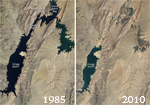Lake Mead, the massive reservoir that supplies water to millions of people across the southwestern U.S., has reached its lowest levels in nearly 75 years. Water levels dropped to 1,083 feet above sea level on Oct. 17, the lowest elevation since 1937, when the lake was first filled with the completion of the Hoover Dam. The dropping water level — which beats a previous record set in the 1950s — underscores the effects of drought and increased water demands on the Colorado River. “Everyone needs to know when we turn on the tap, it drains water out of the river and it has ecological consequences,” Gary Wockner, a campaign coordinator for the conservation group Save the Colorado, told the Arizona Republic. If water levels fall another eight feet, officials would have to implement water restrictions for Arizona and Nevada.
Drought Drops Lake Mead To Lowest Water Level Since 1937
More From E360
-
feature
Why U.S. Geothermal May Advance, Despite Political Headwinds
-
Food & Agriculture
In War Zones, a Race to Save Key Seeds Needed to Feed the World
-
Climate
Lightning Strikes the Arctic: What Will It Mean for the Far North?
-
RIVERS
A Win for Farmers and Tribes Brings New Hope to the Klamath
-
Solutions
Deconstructing Buildings: The Quest for New Life for Old Wood
-
NATURAL DEFENSES
How Restored Wetlands Can Protect Europe from Russian Invasion
-
Solutions
Birds vs. Wind Turbines: New Research Aims to Prevent Deaths
-
FORESTS
Cambodian Forest Defenders at Risk for Exposing Illegal Logging
-
OPINION
The ‘Green’ Aviation Fuel That Would Increase Carbon Emissions
-
CONSERVATION
Out of the Wild: How A.I. Is Transforming Conservation Science
-
Energy
China’s Mega Dam Project Poses Big Risks for Asia’s Grand Canyon
-
Solutions
How Natural Solutions Can Help Islands Survive Sea Level Rise
